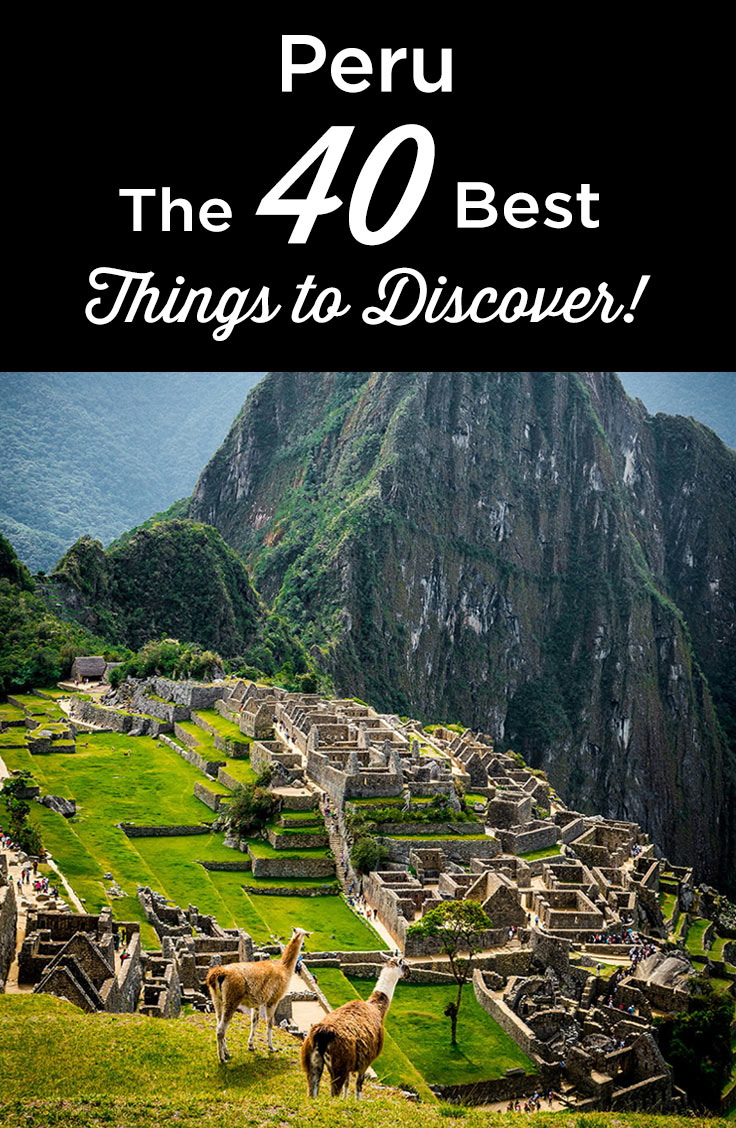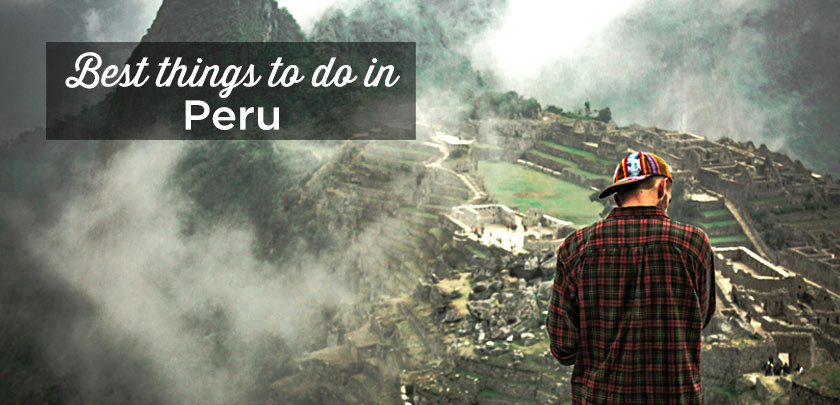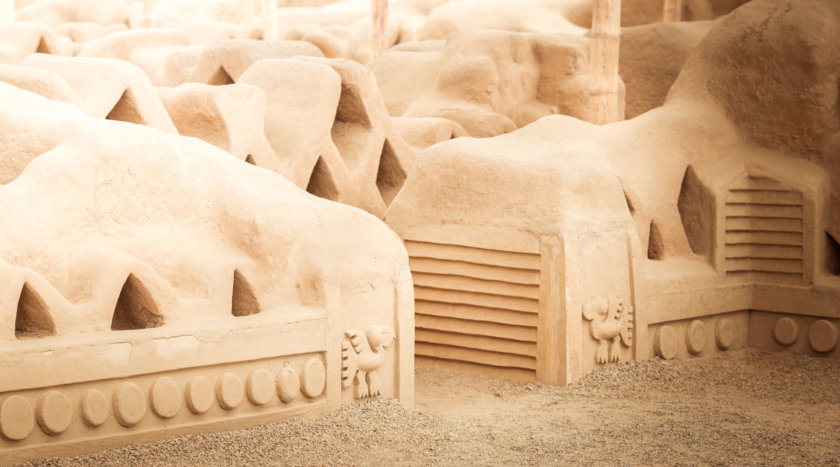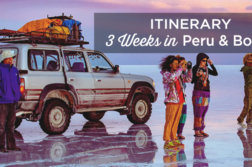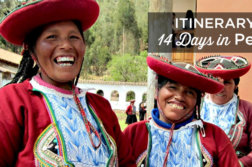The 40 Best Places to Visit in peru
Peru is a country that never stops amazing—from breathtaking mountains to lush jungle, ancient ruins to vibrant cities. But with so many incredible destinations, what are the must-see places in Peru?
To help you plan the perfect adventure, I’ve created this ultimate list of the top 40 places to visit in Peru.
Whether it’s your first trip or your fifth, this guide includes the most iconic attractions—like Machu Picchu, Cusco, and Lake Titicaca—as well as some lesser-known hidden gems that deserve a spot on your itinerary.
You’ll also find plenty of practical tips to help you get around, save time, and truly enjoy each destination.
So, what are the best things to do in Peru?
Let’s find out!
Sommaire
- The 40 Best Places to Visit in peru
- Top 40 Places to Visit in Peru
- 1. Machu Picchu
- 2. Wayna Picchu
- 3. Cusco
- 4. The Rainbow Mountain
- 5. Laguna Humantay
- 6. The fortress of Sacsayhuamán
- 7. Sacred Valley of the Incas
- 8. Ollantaytambo (Sacred Valley)
- 9. Pisac (Sacred Valley)
- 10. Maras and Moray (Sacred Valley)
- 11. Choquequirao
- 12. Lima
- 13. San Francisco Monastery
- 14. Larco Museum
- 15. Pachacámac
- 16. Marcahuasi
- 17. Nazca Lines
- 18. The Huacachina Oasis
- 19. Paracas National Reserve
- 20. Santa Catalina Convent
- 21. Colca Canyon
- 22. Lake Titicaca
- 23. Kuelap Fortress
- How to Get to Kuélap
- 24. Gocta Waterfall
- 25. Revash Mausoleums
- 26. Huascaran National Park
- 27. Lake 69
- 28. Chavín de Huantar
- 29. Trujillo
- 30. Chan Chan
- 31. Huaca of the Moon
- 32. Royal Tombs of Sipan Museum
- 33. The Mangroves of Tumbes
- 34. Q’eswachaka Bridge
- 35. Iquitos
- 36. The Pacaya Samiria Reserve
- 37. The Manu National Park
- 38. Tambopata National Park
- 39. Caral
- 40. Ayacucho
- The Top 40 things to see in Peru
- Book Your Flight at the Best Price
- Rent a Car in Peru
- Traveling to Peru? These articles will help you!
Top 40 Places to Visit in Peru
1. Machu Picchu
Machu Picchu is one of the most iconic archaeological sites in the world and a must-see for any trip to Peru.
Hidden deep in the Urubamba Valley, the ancient Inca city escaped discovery by the Spanish conquistadors—a factor that helped preserve it so well through the centuries.
Today, Machu Picchu is one of the top places to visit in Peru and can be reached via Aguas Calientes, either by train, on foot, or through one of several treks.
Here’s how to get to Machu Picchu:
- By train: Departures from Cusco (3 hours) or Ollantaytambo (1h30).
Book your train tickets here. - By foot: The most budget-friendly way. Take a colectivo to Hidroelectrica, then walk along the railway tracks (2–2.5 hours) to reach Aguas Calientes.
- By trek: The Inca Trail is the most popular route and the only one that arrives directly at Machu Picchu via the Sun Gate. It’s quota-limited, so book months in advance. Alternatives include the Salkantay, Lares, and Jungle Trek.
Once there, you can also hike up to Wayna Picchu or Machu Picchu Mountain for a stunning panoramic view of the site.
There are 3 different tickets available:
- Machu Picchu Ticket (general access)
- Machu Picchu + Wayna Picchu Ticket
- Machu Picchu + Machu Picchu Mountain Ticket
It includes round trip transportation from Cusco (bus to Ollantaytambo train station, train to Aguas Calientes), the bus up to Machu Picchu, with entrance and guided tour of the citadel. You can book it here:
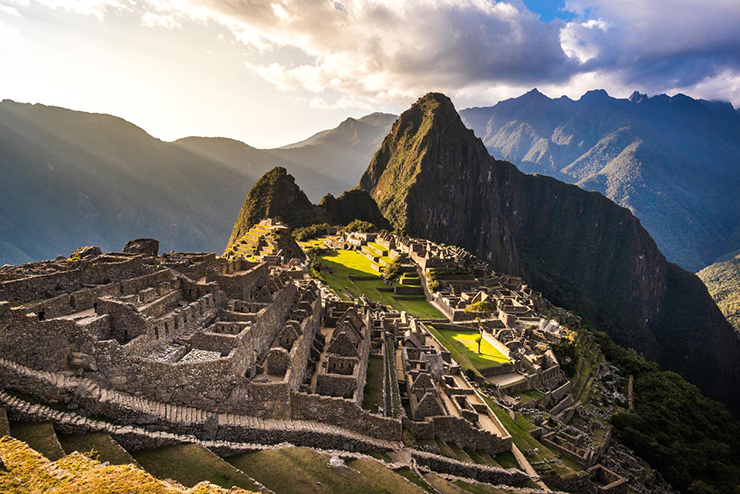
2. Wayna Picchu
Wayna Picchu (8,860 feet) is the iconic peak that appears in nearly every classic photo of Machu Picchu.
Climbing it is an unforgettable adventure, offering breathtaking views over the Inca citadel and the lush Urubamba Valley.
But be ready: the ascent involves steep stairs, narrow trails, and exposed sections. If you’re afraid of heights or have vertigo, this might not be the best option for you.
The round-trip hike takes around 2 to 2.5 hours. Most importantly, you must book several months in advance, as spots are very limited—but it’s absolutely worth it!
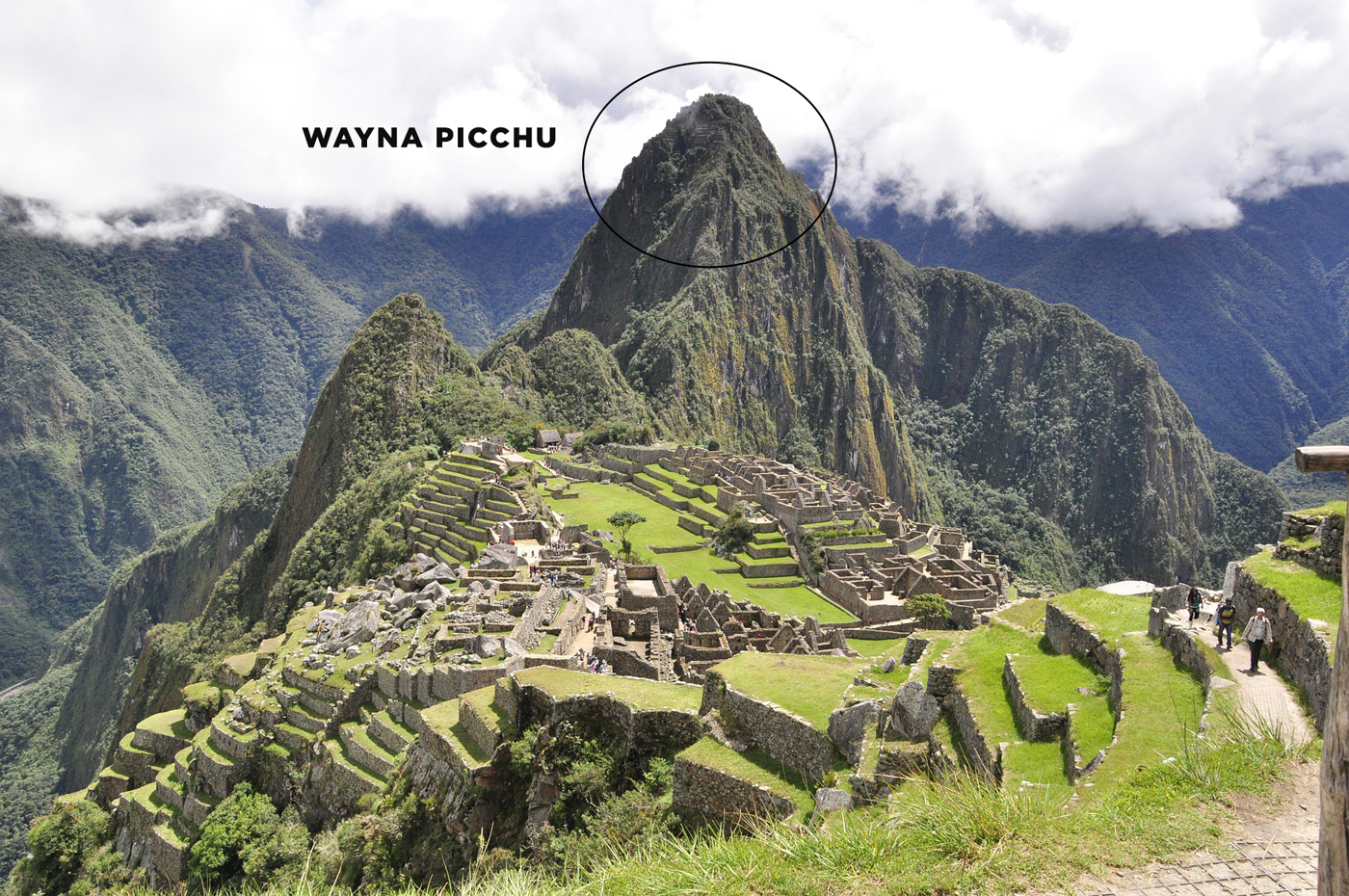
3. Cusco
Capital of the Inca Empire, declared a World Heritage Site, Cusco (or Cuzco) is a must-see in Peru.
This city nestled in the Andes at 11,150 feet altitude is a unique blend of Inca heritage, churches, palaces and squares with baroque and neoclassical architecture.
It is also the starting point for tours to the Sacred Valley, Machu Picchu and Rainbow Mountain.
Here is what to do in Ollantaytambo:
- The Plaza de Armas
- Cathedral Basilica of the Virgin of the Assumption
- Church of the Society of Jesus
- Church of La Merced
- The Coricancha and Convent of Santo Domingo
- The Stone of the 12 Angles
- The museums (ex : museum of popular art, Inka museum, MAP)
- San Pedro Market
- Viewpoint of the White Christ
You can also read:
- 2 or 3 Days in Cusco: What to Do and See?
- Cusco: What to Do in 1 day
- Cusco: The 30 Best Things to See and Visit
- Cusco: 19 Free Activities + Saving Tips
- Cusco: The 17 Best Hotels for Every Budget
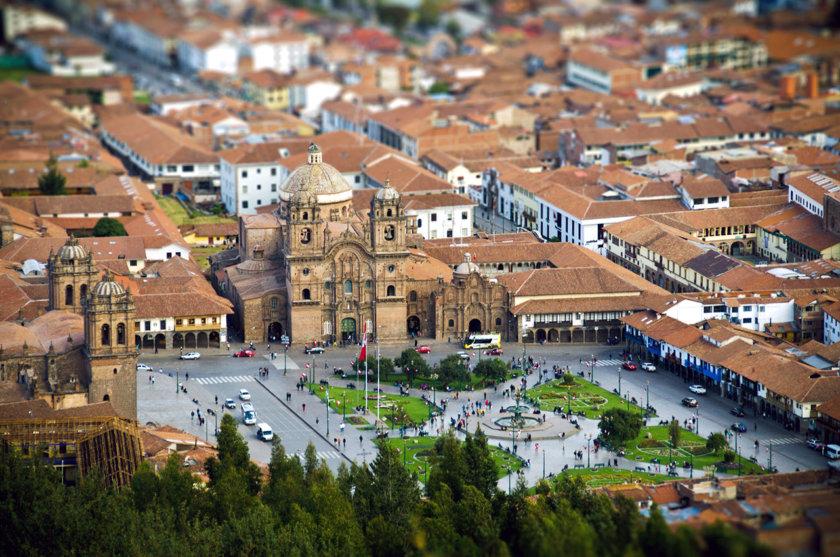
4. The Rainbow Mountain
Its original name is Vinicunca, but it’s more famously known as the Rainbow Mountain or the Mountain of 7 Colors.
Until 2015, the only way to reach it was through the Ausangate Trek. Today, it has become one of the top attractions in the Cusco region, with many agencies offering day or overnight tours to Rainbow Mountain from Cusco.
- Check out My Complete Guide to Visiting Rainbow Mountain for all the details you need!
The mountain stands at 16,400 feet, so it’s essential to spend at least 1 or 2 days in Cusco beforehand to properly acclimate to the altitude.
Most agencies offer a similar itinerary: an early morning departure from Cusco and return around 6:00 PM.
If you prefer to book in advance and avoid comparing countless agencies offering the same service, I recommend this reliable Rainbow Mountain tour.
It includes hotel pick-up in Cusco, entrance fees, guide, breakfast, lunch, and even walking poles—everything you need for a smooth and enjoyable hike.
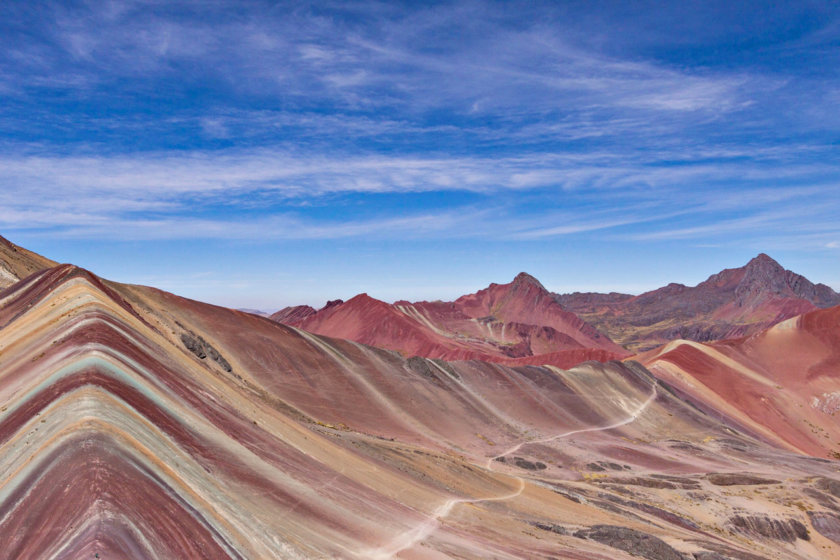
5. Laguna Humantay
Another must-see destination near Cusco is the stunning Humantay Lagoon, located at an altitude of 13,780 feet.
This dazzling turquoise lake, framed by dramatic snow-capped peaks, is one of the most breathtaking landscapes in the Cusco region. The hike itself isn’t very long, but the altitude makes the final section a bit challenging—so take your time and enjoy the views!
The round-trip hike to Laguna Humantay takes about 3 hours, and the reward is well worth the effort. If you’re looking for a full-day experience that blends natural beauty and adventure, this is a perfect choice from Cusco.
The tour includes early morning pick-up, transportation, breakfast, lunch, and entrance to the lagoon. You can book the tour easily here:
- Want to learn more about Humantay Lagoon? Check out My Complete Guide to Laguna Humantay for tips, photos, and practical info.

6. The fortress of Sacsayhuamán
Located on a hill with a magnificent view over Cusco, it is a fortress that is an impressive example of Inca construction techniques: walls made of stone blocks so well carved that they fit together perfectly and do not require any cement.
It is partly here that the great celebration of Inti Raymi, the famous Inca sun festival, takes place on June 24.
Sacsayhuaman is the best known and largest of the 4 Inca archaeological sites around Cusco and it is mandatory to get the tourist ticket to enter.
How to get to Sacsayhuaman:
- By cab: it is the fastest way (10 min)
- By combi: cheaper, you have to look for the vans in the direction of “Cristo Blanco”
- On foot: you have to calculate between 30min to 1h of ascent from the Plaza de Armas, depending on your physical capacity and acclimatization to the altitude
I recommend this guided tour to the 4 archaeological sites with pick up from your hotel in Cusco, excellent value for money!
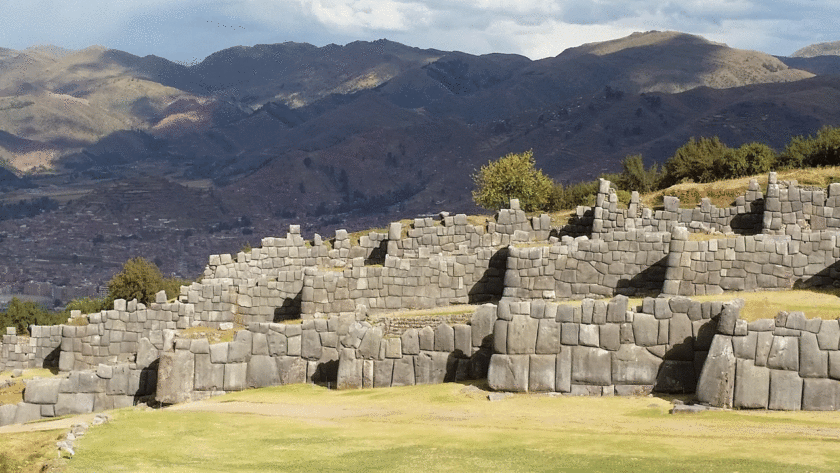
7. Sacred Valley of the Incas
The Sacred Valley is one of those places you absolutely can’t miss in Peru.
Just a short drive from Cusco, this fertile valley was once the agricultural, spiritual, and political heart of the Inca Empire, surrounded by the majestic Andes and following the path of the Urubamba River.
Here, you’ll find some of the most impressive archaeological sites in Peru, like Pisac, Ollantaytambo, and Moray, each offering a glimpse into the genius of Inca engineering and cosmology.
If you’re heading from Cusco to Machu Picchu, be sure to include the Sacred Valley in your itinerary. Skipping it would be a real shame!
- Want to make the most of your visit? Check out My Complete Guide to the Sacred Valley: 23 Best Things to Do!
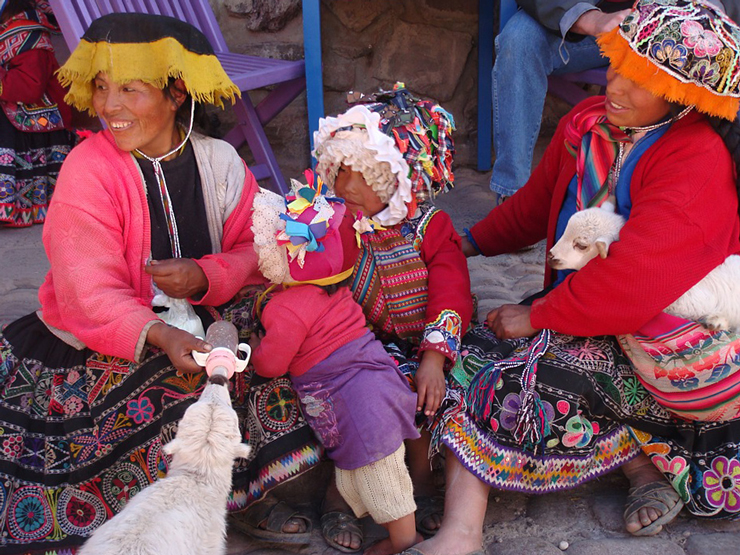
8. Ollantaytambo (Sacred Valley)
Ollantaytambo was one of the most important towns of the Inca Empire, because it served as a checkpoint on the road to Machu Picchu.
Today it is a charming town, with small narrow streets and small squares, which have maintained their original layout.
Here is what to see in Ollantaytambo:
- The fortress of Ollantaytambo (with the tourist ticket)
- Pinkuylluna: free access and offers a great view of the ruins and surrounding area
- Ñaupa Church: a free and little known Inca ceremonial site, which can be reached on foot from the village of Pachar.
- La Cerveceria del Valle: located in Pachar, it is one of the best craft breweries in Peru and has received several international awards
- Inti Punku (the Gate of the Sun)
- The Temple of Pumamarca
Ollantaytambo is one of my favorite places in Peru and deserves at least one day. To learn all about the town and its surroundings, why don’t you check out My Complete Guide to Ollantaytambo.
If you don’t have much time, I recommend you to visit Ollantaytambo with a tour. You can book it here, at the best price:
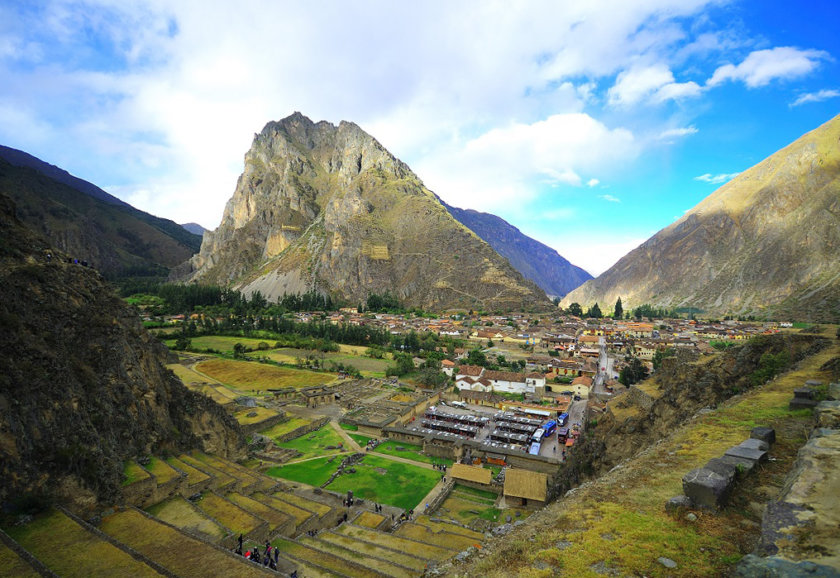
9. Pisac (Sacred Valley)
Pisac is an ancient Inca town, best known for its impressive archaeological site and its vibrant traditional market, held on Tuesdays, Thursdays, and Sundays in the Plaza de Armas.
The ruins of Pisac, once the royal estate of Inca Pachacutec, are among the most beautiful sites in the Sacred Valley. They include agricultural terraces, ceremonial structures, and residential areas—some of the Inca canal systems are still functional today!
- You’ll need the Cusco tourist ticket (boleto turístico) to access the archaeological site.
- To explore all that Pisac has to offer, check out My Complete Article about Pisac
If you’d rather visit with a tour and not worry about transportation, I recommend this one—it covers Pisac, Ollantaytambo, and Chinchero at a great price!
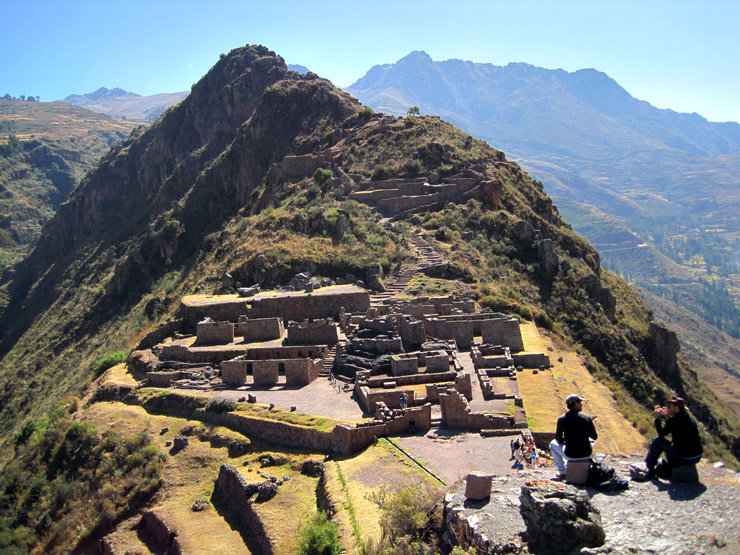
10. Maras and Moray (Sacred Valley)
The salt mines of Maras have been used since Inca times to extract salt by evaporation from a very salty natural water source.
Today there are more than 3000 wells exploited by 800 families in the region: one of the most beautiful spectacles of the Sacred Valley and an excellent place to take pictures!
Only 4 miles from Maras, you will find Moray which was an Inca agricultural research center.
Thanks to a system of terraces, the Incas managed to create 20 microclimates in the same place.
They were able to cultivate plants from different regions of the Andes and the jungle!
- The entrance to Maras costs 20 soles and to enter Moray, you will need to buy the Tourist Ticket
- You can get to Maras and Moray from Cusco by cab, with a tour or by colectivo + cab. For all the details, here is My Complete Article about Maras and Moray.
Easily book the tour to Maras and Moray from Cusco by clicking here:
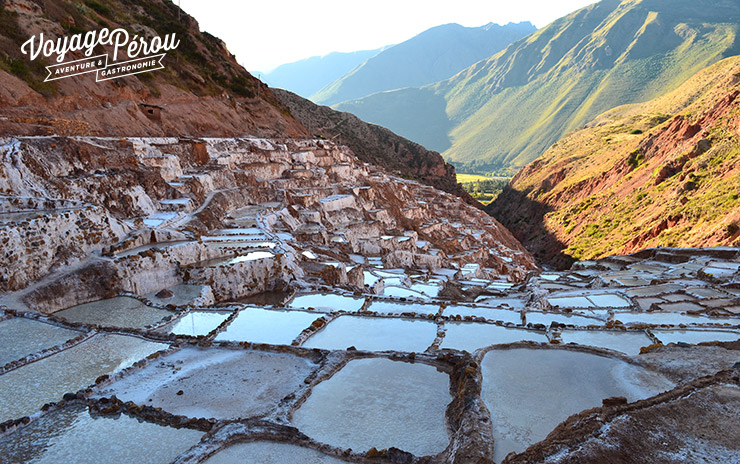
11. Choquequirao
Located at over 9,840 feet altitude, Choquequirao is an Inca complex similar to Machu Picchu in its structure, with several buildings and terraces.
It is smaller, but has the advantage of being much less touristy because it can only be reached on foot!
To get to Choquequirao from Cusco, you can hike with or without a guide, although I do recommend doing it with a guide as it can take 4 to 10 days depending on the itinerary chosen.
- I invite you to read The Definitive Guide to Choquequirao
You can book your trek to Choquequirao with a serious agency here:
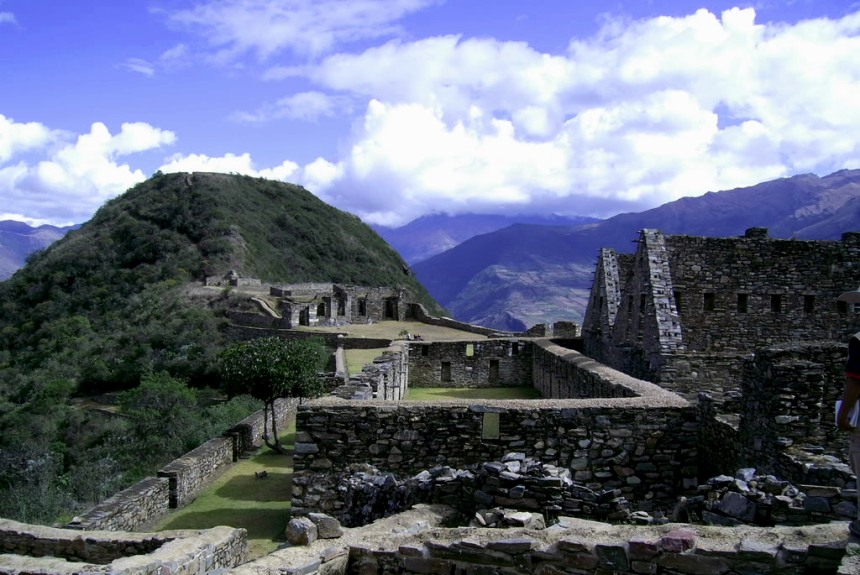
12. Lima
To visit Lima is to discover the capital of Peru, a city that was the most important in South America in colonial times and today is a reference in world gastronomy.
Although its reputation as a gray and chaotic city persists, having lived there for 4 years, I can assure you that Lima has a lot to offer, between archaeological sites and modern neighborhoods.
Not to mention the most beautiful sunsets overlooking the Pacific Ocean!
You can walk through its Historic Center, with the Cathedral and its elegant colonial buildings, stroll along the Malecon of Miraflores overlooking the Pacific, and end up in the bohemian neighborhood of Barranco, famous for its urban art, bars and cultural atmosphere.
For all the best things to do in Lima, check out my complete guides:
- Lima: Top 25 Things to Do and See
- Lima: What to Do and See in 2 Days
- Lima in 1 day: The Definitive Itinerary + My best tips
- Lima: The 25 Best Hotels to Stay
If you don’t have much time to visit Lima, I suggest this guided tour of the must-see places in the historic center, with round-trip transportation. Book it here:
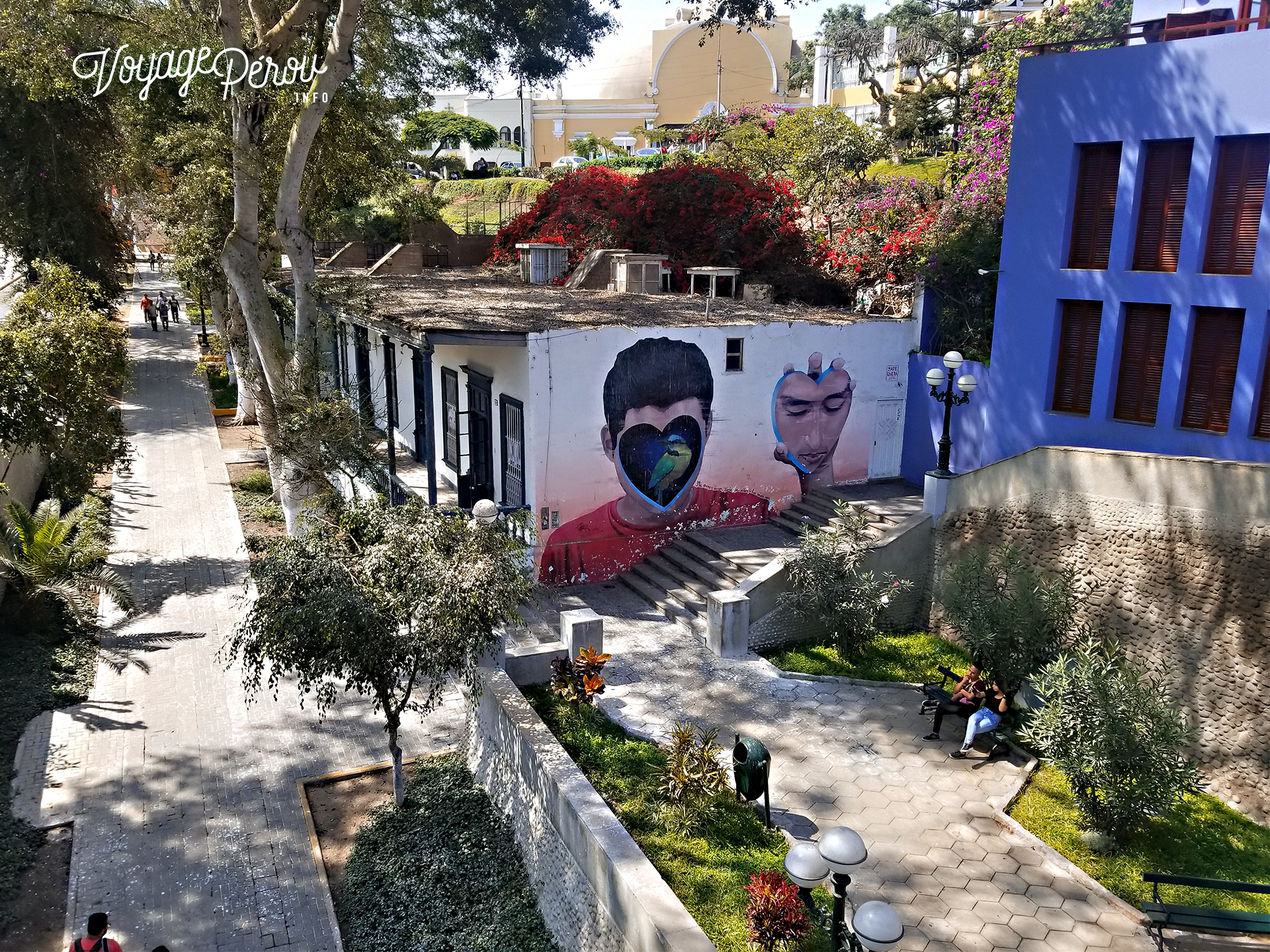
13. San Francisco Monastery
The Monastery of San Francisco, just a short walk from the Plaza de Armas, is one of the top historical attractions in Lima.
Dating back to the 17th century, the monastery features a magnificent library, beautiful paintings from the Cusco School, and the famous catacombs—a network of underground tunnels where thousands of bones are stored.
I discovered them thanks to this street food tour in downtown Lima, and now it’s one of my favorite spots in the city.
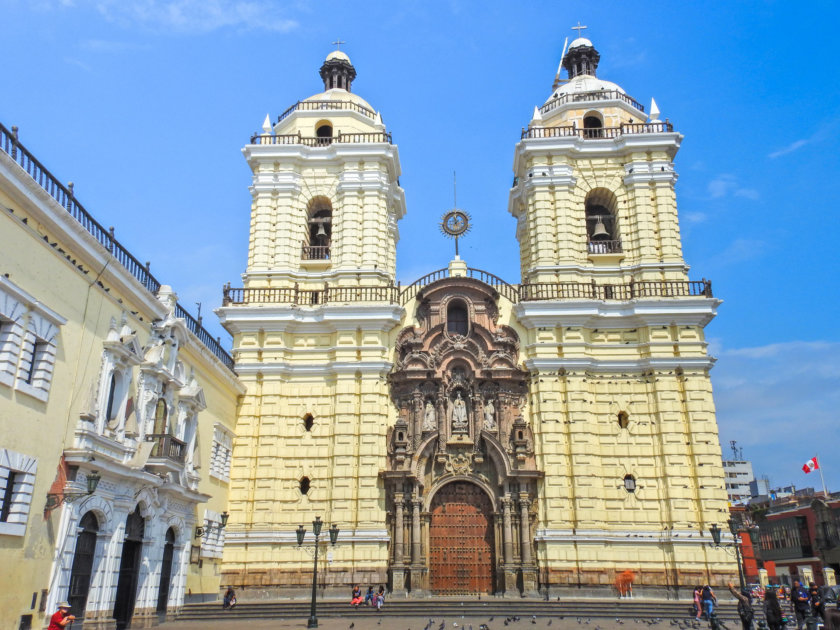
14. Larco Museum
The Larco Museum is one of the most important museums in Peru, showcasing an impressive collection of pre-Columbian art.
Set inside a beautiful 18th-century mansion, it offers a journey through 4,000 years of Peruvian history, featuring gold and silver jewelry, ceramics, textiles, sculptures, and artifacts from Inca and pre-Inca cultures.
One of its most unique features is the world’s largest collection of pre-Columbian erotic art, displayed in a separate gallery that draws curious visitors from around the globe.
What’s even more surprising is that the museum’s storage room is also open to the public, giving you access to more than 30,000 archaeological objects rarely seen elsewhere!
Don’t forget to enjoy a break in the museum’s charming garden café—its terrace is the perfect spot for a drink surrounded by colorful flowers.

15. Pachacámac
20 miles south of Lima is Pachacámac, a sacred site of great importance built more than 1000 years ago, and which was occupied by the Lima, Wari, Yschma and Inca cultures.
It was a commercial crossroads and administrative center, as well as one of the most important pilgrimage sites on the coast and in the Andes.
Here they came to make offerings to the creator god Pachacamac and to consult the oracle.
How to get there:
- With a tour (much easier)
- By bus to the station “Cruce de Pachacamac” + colectivo (bus)
Since it is outside of Lima, I suggest you take a guided tour to Pachacamac that includes transportation from your hotel:
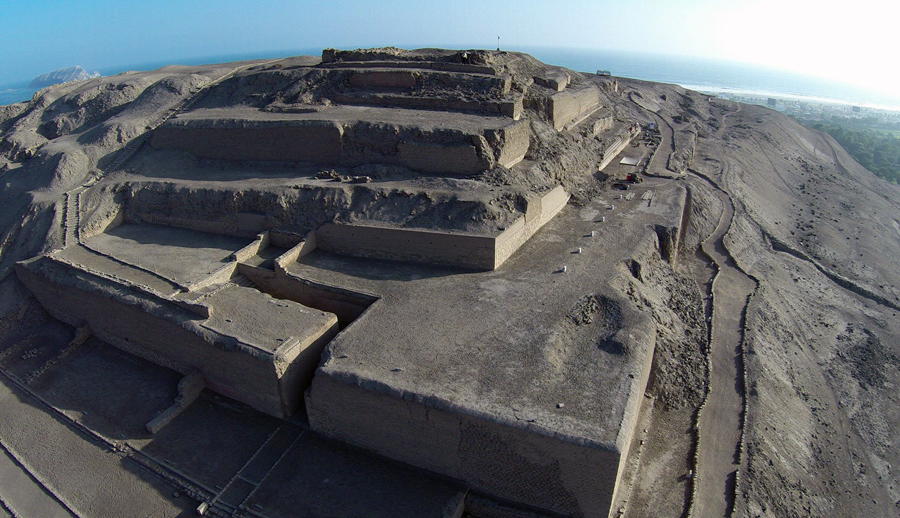
16. Marcahuasi
Marcahuasi is a volcanic plateau at 13,120 feet altitude, located only 2 and a half hours from Lima.
Known as the “forest of stones”, this 1.5 square mile site is distinguished by its unique rock formations, with figures such as the Monument to Humanity, The Mushroom and The Alchemist.
It is one of the best places to camp near Lima, ideal for enjoying a spectacular starry sky and an unforgettable sunrise from La Fortaleza, its highest point.
The safest camping area is El Anfiteatro, surrounded by high rocks that protect from the wind.
Marcahuasi is also home to pre-Inca ruins of the Huanca and Masma cultures, with chullpas (burial towers) and agricultural terraces, as well as the Cachu Cachu, Laguna Cinco and Laguna Huacracocha lagoons.
Since the terrain is rocky and the trails are not well marked, caution is advised.
For a safer and more enriching visit, you can hire a local guide (2 hours for 20 soles or 4 hours for 40 soles), thus supporting the economy of the local community.
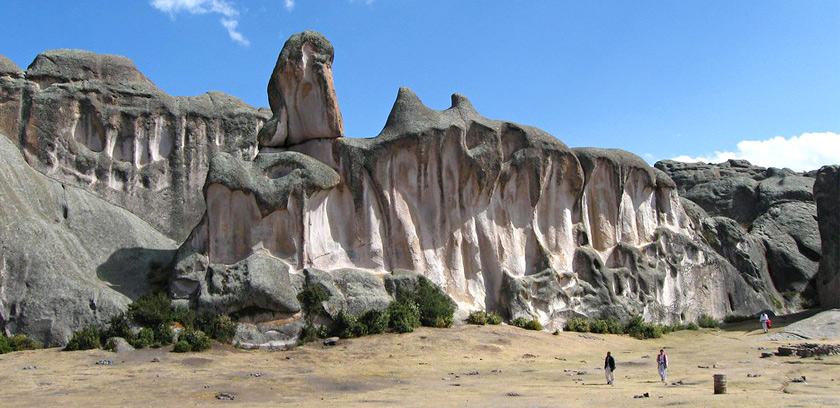
17. Nazca Lines
The Nazca Lines are one of Peru’s most famous tourist attractions, yet little is known about their origin.
It is a set of lines, which form drawings and geometric figures, drawn between 500 BC and 500 by the Nazca culture over some 290 square miles.
It is believed that they could have been part of a cult to the god of water, particularly important in such an arid climate, or have been used as an astronomical tool by pointing to important coordinates in the sky.
Some of them can be seen from a lookout tower, but the best way is, of course, to fly over the Nazca lines with a small plane.
Here are the other attractions of Nazca, which are very interesting but little visited:
- Chauchilla cemetery of the Inca-Chincha culture with very well preserved 1000 year old mummies
- Antonini Museum
- Cahuachi, a sacred place of the Nazca people
- Subway aqueducts of Cantalloc
- Los Paredones Ruins
- Marie Reiche Museum
- Palpa Lines
- Buena Fe Lines
- Maria Reiche Planetarium
- Take a tour in a dune buggy
- Practice sandboarding on Cerro Blanco, the highest sand dune in South America!
I recommend you to read Nazca: All About the Nazca Lines + My tips
Since because of the wind, flights can be postponed, I suggest you to book your flight earlier (8am or 10am at the latest). You can do it here:

18. The Huacachina Oasis
La Huacachina is a natural oasis surrounded by desert dunes, palm trees, and cozy hotels—one of the most unique places to visit in Peru.
It’s the perfect spot to spend a day or weekend sandboarding down the dunes or enjoying an adrenaline-filled ride in a desert buggy.
Don’t miss the sunset from the top of the dunes—watching the sky change colors over the desert is a truly unforgettable experience!
I recommend this buggy and sandboarding tour with hotel pick-up from Ica or La Huacachina:
- Want more tips? Check out my full article: La Huacachina Oasis: How to Buggy and Sandboard

19. Paracas National Reserve
Paracas is definitely a place you must visit in Peru.
It is a protected area of 1,290 square miles that encompasses the desert, the sea and some islands.
In addition to its unique landscape and archaeological remains, it is home to dolphins, Humboldt penguins, sea lion colonies and some 60 species of birds.
Here’s what to do and see in Paracas:
- Enjoy the beaches like La Mina
- Eat fresh seafood at the port of Lagunillas
- Take a boat tour to the Ballestas Islands
- See the Julio C. Tello museum collection of the Paracas culture
- El Candelabro: a 390 feet geoglyph carved in the sand
- Go buggy and sandboarding
You can book the Ballestas Islands tour here:
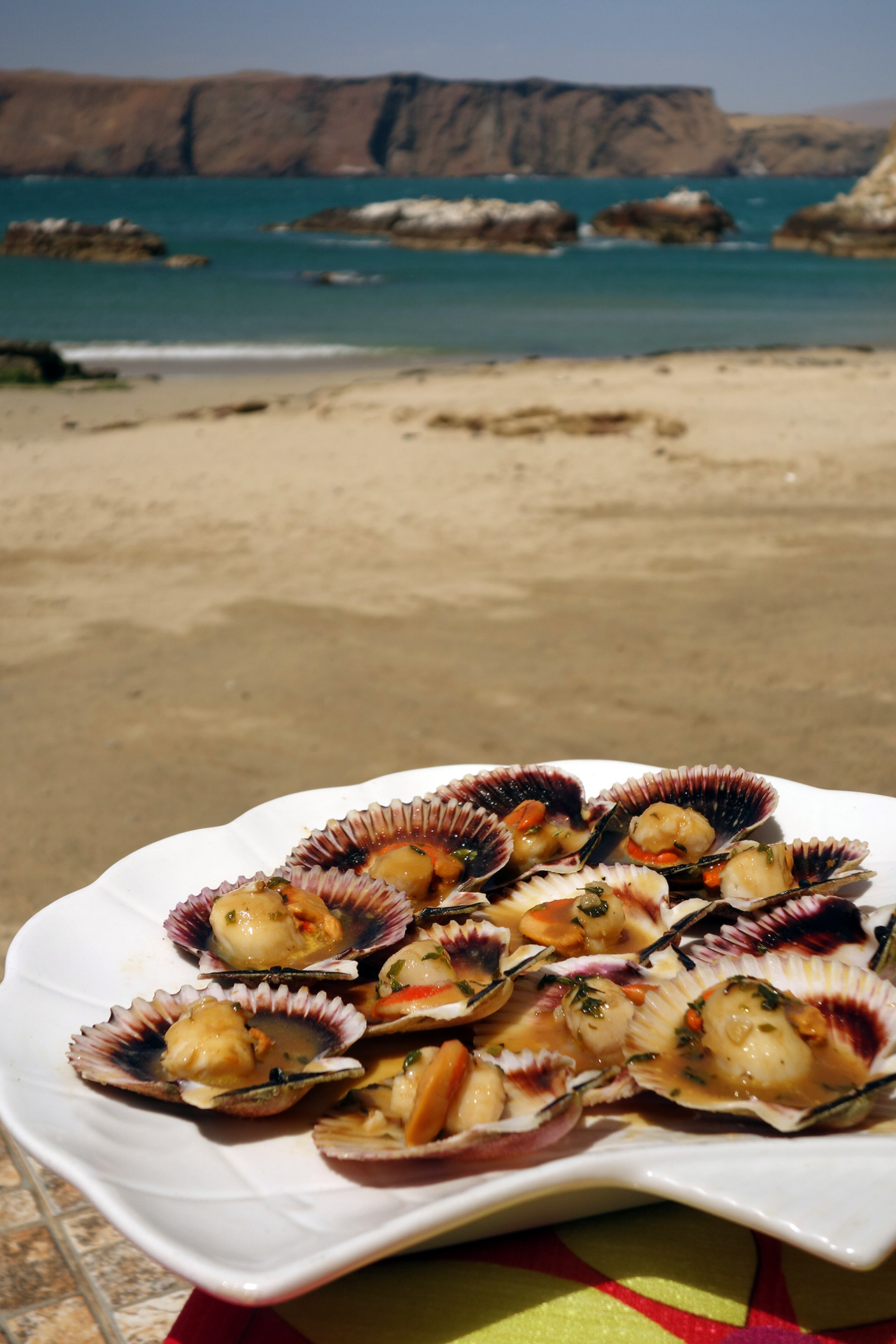
20. Santa Catalina Convent
With its 220,220 square foot, Santa Catalina in Arequipa is the largest religious building in the country and a must-see in Peru.
It was built in 1579, and up to 450 nuns and their servants lived there!
Today it is open to the public and you can discover its charming narrow streets and red and blue squares.
I invite you to read:
- The Best Itinerary to Visit Arequipa in 1 Day
- 2 or 3 Days in Arequipa: What to Do and See?
- Arequipa: 20 Things you Can’t Miss!
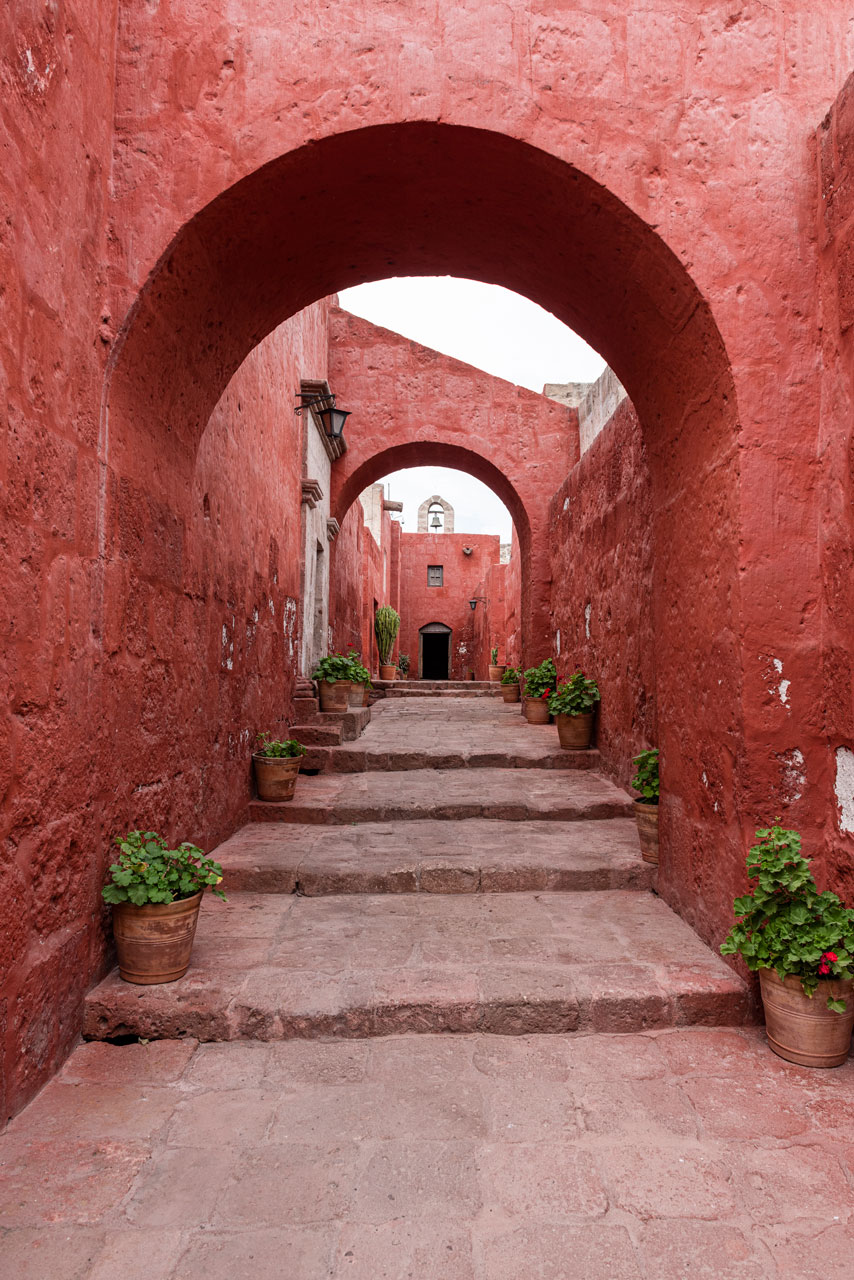
21. Colca Canyon
Twice as deep as the Grand Canyon of Colorado, the Colca Canyon in the Arequipa region is the 2nd deepest canyon in the world, just after its neighbor the Cotahuasi Canyon.
It is one of the places to visit in Peru, with its small villages, its hot springs, the Cruz del Condor and its agricultural terraces.
Here are the options to visit the Colca Canyon:
- 1 day round trip from Arequipa (very short with a lot of route, I do not recommend it)
- 2 days and 1 night tour in Yanque or Chivay, from Arequipa
- 1, 2 or 3 day Colca Canyon trek from Cabanaconde, with or without guide
Discover all the practical information with My Complete Article on the Colca Canyon
You can book the 2 day Colca Canyon tour here:

22. Lake Titicaca
Located at 12,500 ft above sea level on the border between Peru and Bolivia, Lake Titicaca holds the title of the highest navigable lake in the world.
While it’s possible to take a day trip to Lake Titicaca from Puno, I highly recommend spending at least one night with a local family. It’s the best way to experience the lake’s culture and authenticity.
Here are the main places to visit on the Peruvian side of Lake Titicaca:
- Taquile Island – Famous for its traditional weaving, recognized by UNESCO
- Amantani Island – Known for its homestays and stunning lake views
- The Uros Floating Islands – Made entirely of totora reeds
- The Llachón community – A peaceful, less touristy village on the Capachica Peninsula
- Sillustani – Impressive pre-Inca funerary towers with panoramic views
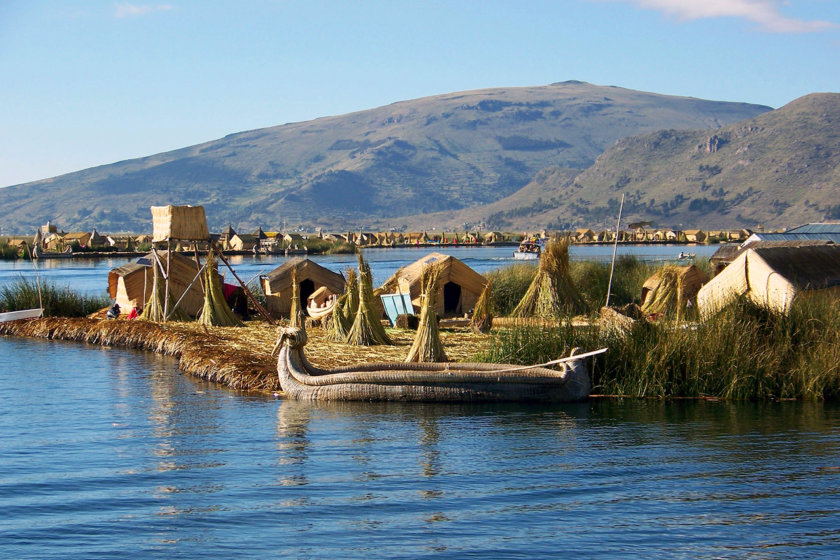
23. Kuelap Fortress
Built by the Chachapoyas civilization around the 11th century, Kuélap is a majestic fortress located in northern Peru. The name “Chachapoyas” means “warriors of the clouds,” and when you stand atop this site, high above the cloud-covered mountains, the meaning becomes crystal clear.
Kuélap is the largest pre-Inca fortified city in South America, and surprisingly, it remains one of Peru’s best-kept secrets—still untouched by mass tourism.
How to Get to Kuélap
With a tour: The easiest and most comfortable way to visit Kuélap is to book a guided tour from Chachapoyas. I recommend this 2-day excursion which includes hotel pick-up, guided visits to Gocta Waterfalls and Kuélap, as well as lunches.
You can book it here:
On your own:
- By cable car: Take a colectivo to Nuevo Tingo (leaves every hour, 1h–1h30, about 9 soles). From there, walk to the boarding station and buy your cable car ticket (21.70 soles, 20-minute ride).
- By foot: If you prefer to hike, head to Old Tingo (Tingo Viejo) instead of Nuevo Tingo. From there, you can begin the 4-hour ascent to Kuélap. If you’re tired after the visit, you can take the cable car down.
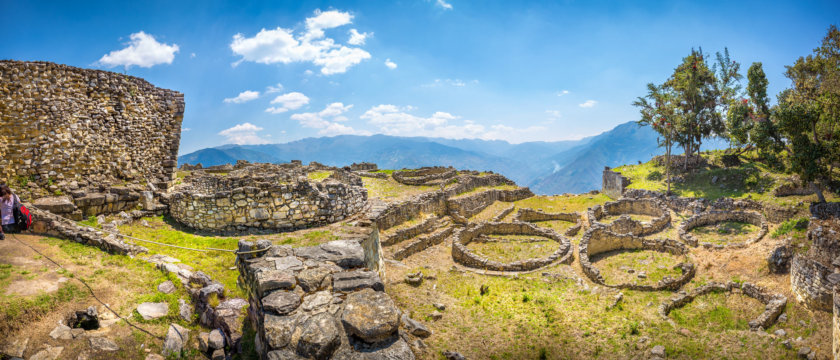
24. Gocta Waterfall
The Gocta waterfall is one of the most beautiful natural wonders of Peru!
It is formed by two waterfalls, located in the province of Chachapoyas in northern Peru.
At 2,530 feet high, Gocta is the third highest waterfall in the world.
How to get to Gocta:
- On your own: take a bus to Cocachimba, then you have to walk 3-4 hours on a trail. Entrance fee 10 soles. Be careful, the last bus back is at 5pm!
- With a tour from Chachapoyas: includes transportation, hike with a local guide, entrance fee and lunch at a local restaurant.
This is the easiest way to get to Gocta, book the tour here:
- To organize your trip, I recommend reading Gocta Waterfall: How to Get There + My Tips
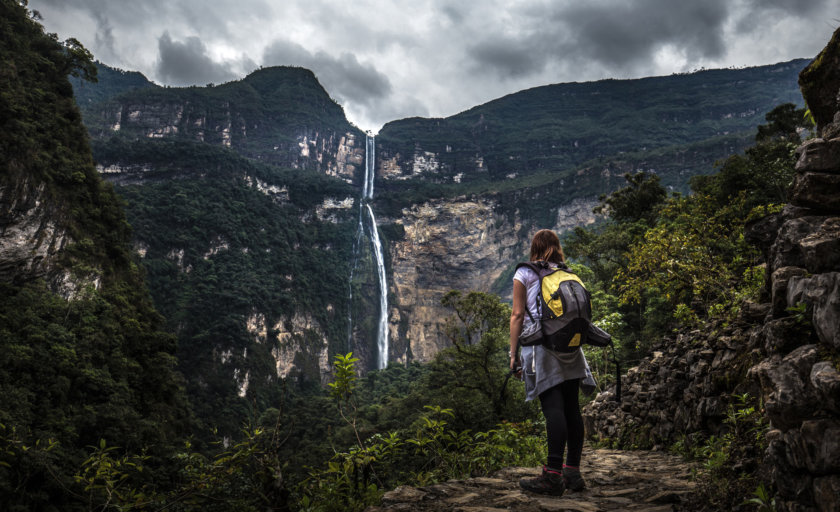
25. Revash Mausoleums
Revash is a burial center located in the Chachapoyas region and is made up of small houses built integrating with the cliff.
There is still a lot of mystery surrounding the site, but it is known that these mausoleums housed mummies of the elite.
- For more explanations about Revash and to see the mummies, you can go to the leymebamba museum.
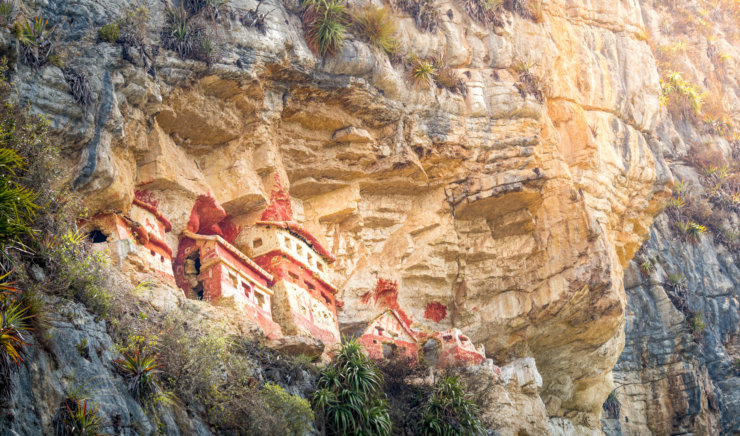
26. Huascaran National Park
With some 25 hiking options and 102 climbing options, Huascaran National Park is a place to visit in Peru for all ecotourism and adventure tourism enthusiasts.
Across its 1,312 square miles, this immense park is home to Huascarán (22,200 feet), the highest peak in Peru and the fourth highest in South America.
The park is also home to 33 archeological sites, a multitude of lakes and glaciers, and has been declared a Biosphere Reserve and Natural World Heritage Site.
Best things to do in Huascaran Park:
- Santa Cruz Trek
- Pastoruri Trek
- Llanganuco Lakes (Chinancocha Lagoon and Orconcocha Lagoon)
- Lagoon 69
- Querococha Lagoon
- Mountain biking
- Ski
- Climbing (on ice and rock)
I recommend reading Huaraz: The 17 Best Touristic Attractions
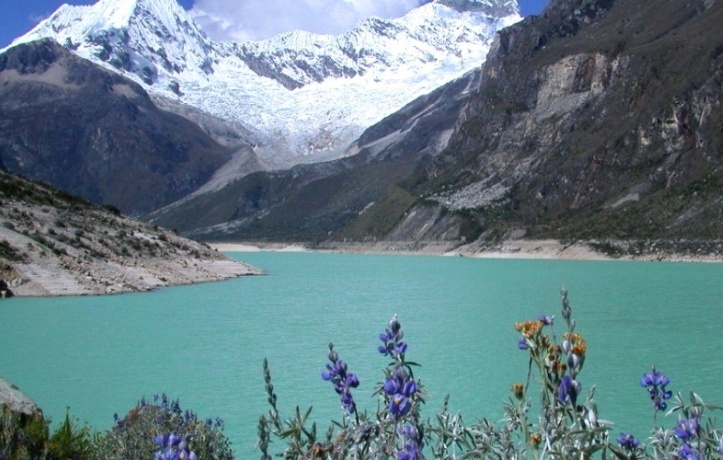
27. Lake 69
Another must-see destination in Peru: Laguna 69.
Located at an altitude of 15,090 feet in the heart of Huascarán National Park, this breathtaking turquoise lake is surrounded by towering snow-capped peaks. It’s considered one of the most stunning hikes in the Ancash region, with spectacular scenery every step of the way.
The hike to Laguna 69 takes around 3 to 4 hours round-trip, with a steady ascent and a final steep stretch that requires a bit of effort.
Due to the high altitude, I highly recommend spending at least one full day in Huaraz to acclimatize before setting out.
The trek starts from Huaraz, and you can easily join a guided day tour that includes transport and lunch. It’s a convenient and safe way to enjoy the hike. Book it here:
- To plan your visit to Laguna 69 and discover more amazing experiences in the area, check out My Complete Guide to Huaraz!

28. Chavín de Huantar
Chavín de Huantar is an important archaeological site of the Chavín culture.
It was an important ceremonial and pilgrimage center, as well as a checkpoint for trade routes from the Pacific to the Amazon Jungle.
As it was a meeting point for many peoples from the coast, the Andes and even the jungle, it became a place of ideological, cultural and religious exchange.
Here was an impressive 2 miles labyrinth designed for the initiation of priests: a set of tunnels and galleries with little light and acoustic effects (voice changes, strong echoes, etc.) used by the priests to terrify them.
In addition, they were under the hallucinogenic effect of the San Pedro Cactus enough to drive them crazy!
How to visit Chavin de Huantar from Huaraz:
- By public transport: it is possible but the return trip is complicated because the distances are long, I do not recommend it
- With a tour (9h30 to 20h): it is the best option because it includes the pick up from your hotel, the guided visit of the archaeological site and the museum that allows you to learn more about the Chavin culture. Book it here:
I recommend you watch this great National Geographic report on Chavin and its rituals, it’s very well done!
29. Trujillo
Trujillo is a colonial city, considered the cultural capital of Peru, on the one hand because of its Mochica and Chimú vestiges, but also because it was the birthplace of many of the country’s great intellectuals.
Today it hosts the great Marinera Festival, a beautiful typical dance of the coast, during which several events are held, including the National Marinera Contest.
What to see in Trujillo:
- The Museum of Religious Art
- The Urquiaga House
- The Archeology Museum
- The Ganoza Chopitea House
- The House of the Lions
What to see around Trujillo:
- The seaside resort of Huanchaco
- The Huacas of the Sun and the Moon
- The Chan Chan archaeological zone
- The Emerald Huaca
- The Huaca Arco Iris also called Huaca del Dragon (Dragon Huaca)
- The Brujo
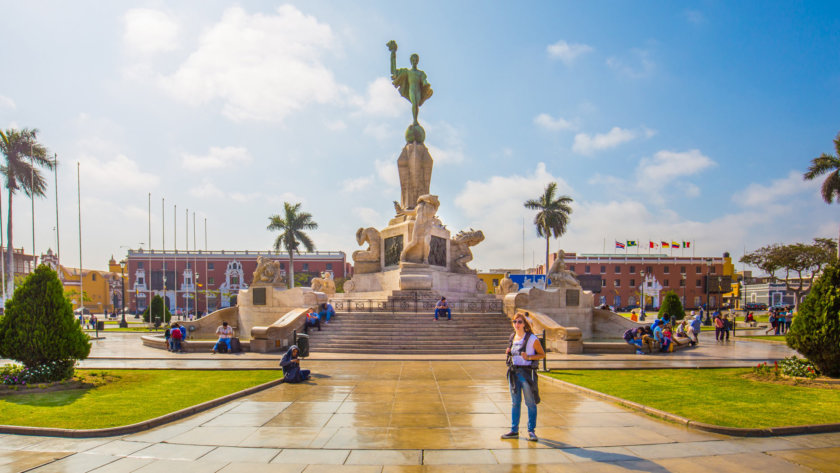
30. Chan Chan
Just a few kilometers from Trujillo is Chan Chan, which is the largest pre-Columbian city in South America.
It is a large adobe complex composed of 6 different types of structures (temples, palaces and houses), and was the capital of the Chimu Empire before its conquest by the Incas.
Today it is a UNESCO World Heritage Site and you can see its impressive reliefs representing birds, fish and geometric shapes, the Tschudi Palace and the interesting site museum.
 31. Huaca of the Moon
31. Huaca of the Moon
It is a Mochica archaeological complex composed of two temples: one dedicated to the Sun (Huaca del Sol), which is closed to the public, and the other to the Moon (Huaca de la Luna).
The visit to the Temple of the Moon is interesting and quite special: besides starting in the place where human sacrifices were performed, you can observe the bas-reliefs representing the god Ai-Apaec “the Decapitator”.
The entrance includes a guided tour (mandatory) that allows you to understand the magnitude and importance of the site.
How to get to Huaca de la Luna:
- By bus and colectivo from Trujillo: first take a bus to Ovalo Grau, and then a colectivo (30 min. trip) in the direction of Huaca del Sol.
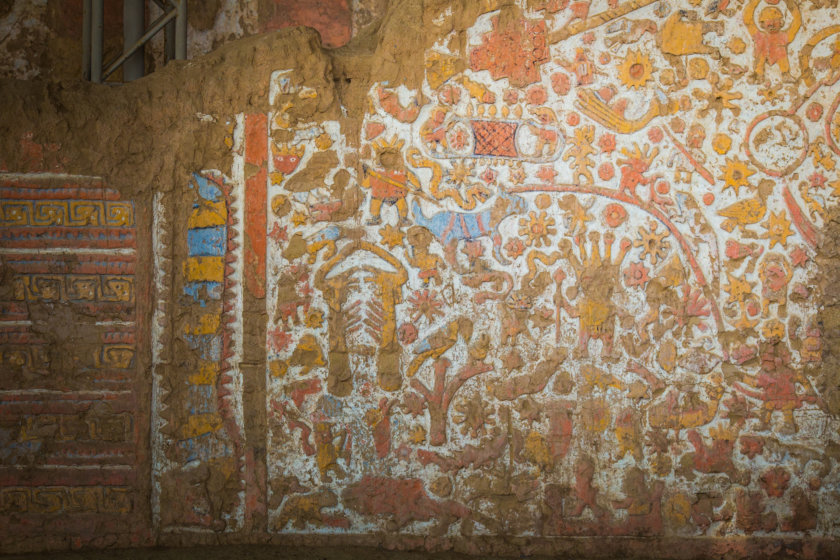
32. Royal Tombs of Sipan Museum
The Royal Tombs Museum, also called the Lord of Sipan Museum, is considered by many as the most beautiful museum in Peru.
- Take a look: What to Do and See in Chiclayo + Where to Stay
It is located in Chiclayo and presents an impressive collection of 2,000 objects (gold, silver, copper, ceramics) found in the Huaca Rajada, the most important burial complex of the Mochica culture, which protected the 2,000 year old tomb of the Lord of Sipan.
How to visit the Royal Tombs museum:
- By cab: 30 minutes from downtown Chiclayo
- With a tour from Chiclayo: it is the best option because the distances are long and it costs the same as a cab… with more advantages! The tours include the pick up from your hotel, the guided visit to the Royal Tombs, and also to the pyramids of Tucume and the national museum of Sicán

33. The Mangroves of Tumbes
On the border with Ecuador is the Tumbes Mangrove National Sanctuary, which protects the most important mangrove area in Peru.
The islets and canals serve as refuge for many birds, fish, mollusks and crustaceans, in addition to a very special tree called mangrove.
The ideal is to stay there for two days. You can go kayaking, hiking, bird and flora watching.
What to see in Tumbes:
- Puerto Pizarro
- La Isla del Amor, in front of Puerto Pizarro
- Cruz de Pizarro Cove
- Punta Sal Beach
- Zorritos Beach
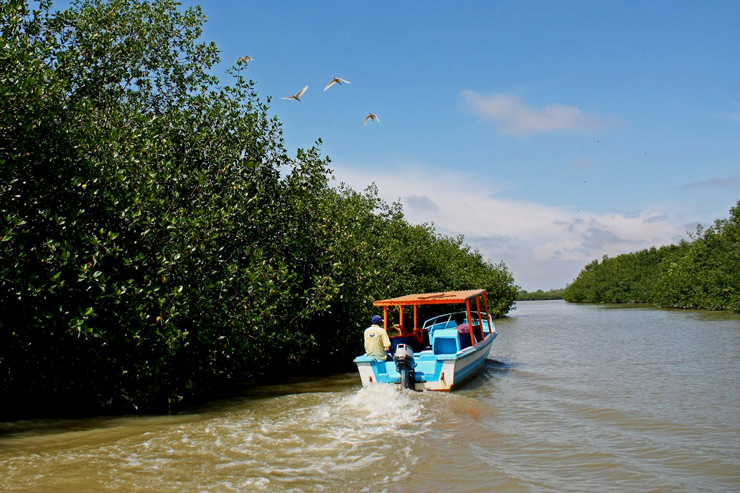
34. Q’eswachaka Bridge
The Q’eswachaka Bridge is one of the must-see sites in Peru, as it represents a unique heritage of the Inca culture!
Every year, in the month of June, the local communities gather for 4 days to rebuild it using ichu plant fiber, just as their ancestors did.
This process highlights the preservation of ancestral traditions and community cooperation: the women weave the ropes, while the men dismantle the old bridge and install the new one.
On the last day, the reconstruction ends with a big celebration with music and traditional dances!
The other option, much easier, is to Book a Tour to the Q’eswachaka Bridge from Cusco, which also includes the lakes of Pampamarca, Asnacqoccha, Acopia and Pomacanchi.
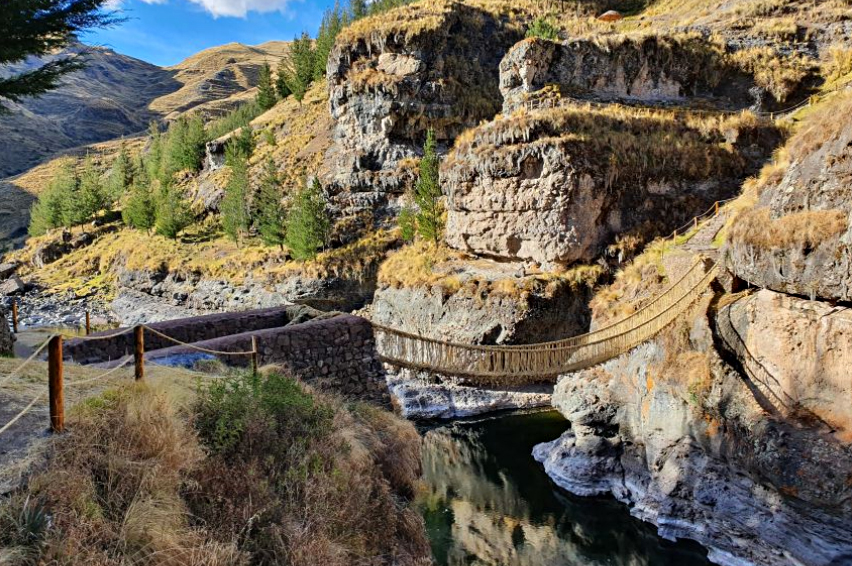
35. Iquitos
Iquitos is one of those cities that you can’t miss in Peru.
Known for being the largest city in the world with no road access, it can only be reached by boat or plane, which makes it truly unique.
Located in the heart of the Peruvian Amazon, it is the capital of Loreto and an important cultural and commercial center.
Surrounded by the tributaries of the Amazon River and close to the borders with Ecuador, Colombia and Brazil, Iquitos is the ideal starting point for an adventure in the Amazon jungle.
From the Amazon lodges or local communities, you will be able to observe the incredible biodiversity of the region, with species such as pink dolphins, monkeys, sloths, caimans and a great variety of exotic birds.
Among the must-see places in Iquitos are the Belen Market, the Pacaya Samiria National Reserve, the Malecon Tarapacá and the Monkey Island each with unique experiences of the Peruvian jungle.
Book here!
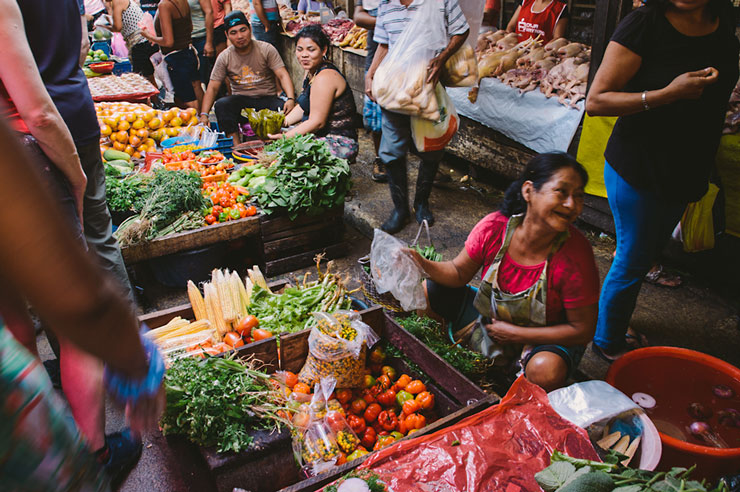
36. The Pacaya Samiria Reserve
Located in the heart of the Amazon rainforest, in the Iquitos region, the Pacaya Samiria National Reserve is the second largest protected natural area in Peru.
It’s one of the most extraordinary places to visit in Peru, still relatively off the beaten path due to its remote location and the need to plan at least 4 to 5 days to explore it properly. That said, tourism here is well-organized and fully accessible with a bit of planning.
Pacaya Samiria is home to an incredible diversity of wildlife: from the famous pink Amazon dolphins to sloths, monkeys, caimans, jaguars, giant turtles, anacondas, and hundreds of species of exotic birds.
You’ll also have the opportunity to visit indigenous communities such as the Bora people, who share their culture and ancestral traditions with visitors.
Note that visiting Pacaya Samiria requires a guide, either privately or in a small group, to ensure the protection of this fragile ecosystem.
How to get to Pacaya Samiria from Iquitos:
- Step 1: Fly from Lima to Iquitos (1h30)
- Step 2: Take a bus or shared taxi from Iquitos to Nauta (2 hours)
- Step 3: Board a boat from Nauta to the entrance of Pacaya Samiria (2 hours)
It’s also possible to arrive via Tarapoto or Yurimaguas, though Iquitos remains the most popular gateway.
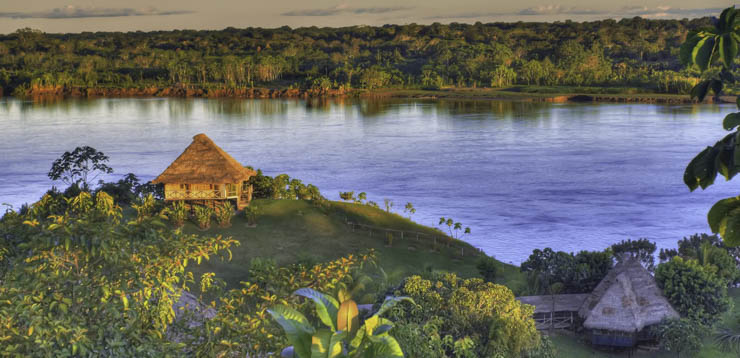
37. The Manu National Park
Manu Park is another of the treasures of the Peruvian Amazon and a must-see on a trip to Peru.
Located between the departments of Madre de Dios and Cusco, it has the advantage of being accessible from the city of Cusco, making it an excellent extension for a classic itinerary in Peru.
The park has a rich biodiversity, well preserved and hidden in the jungle. It is an ideal place for travelers who have time and wish to experience a true immersion in the Amazon.
Trips vary from 3 to 12 days and generally include day and night hikes, boat rides, bird watching, monkeys and other exotic species of the local fauna.
And there is so much to see! The park is home to 20,000 species of plants, 1,200 species of butterflies, 1,000 species of birds, 200 species of mammals and 13 species of primates.
This is how to get to Manu National Park from Cusco:
- Bus or colectivo (9h) from Cusco to Paucartambo
- Boat (6h) to Boca Manu
It is a complete tour that includes transportation, lodging in ecolodge and several activities, book here!
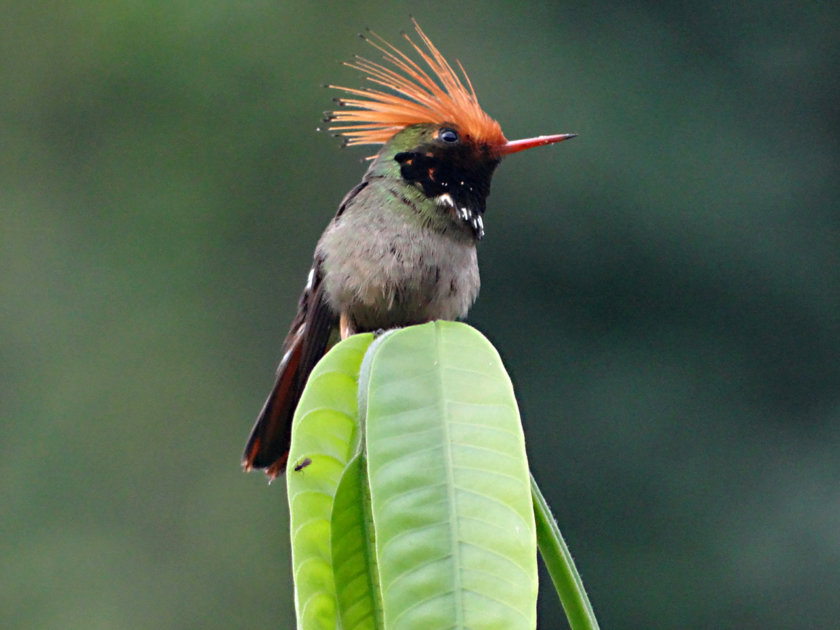
38. Tambopata National Park
Tambopata National Park is one of the must-see destinations in Peru, ideal for those who want to live an authentic Peruvian Amazon experience.
It is located in the Madre de Dios region and is accessible from the city of Puerto Maldonado, the starting point for exploring this incredible natural reserve.
Known for its impressive biodiversity, Tambopata is home to macaws, caimans, monkeys, jaguars and a great variety of birds, reptiles and insects.
Among its most popular attractions is Lake Sandoval, a perfect place to take a boat ride and observe Amazonian wildlife up close.
You can book it here:
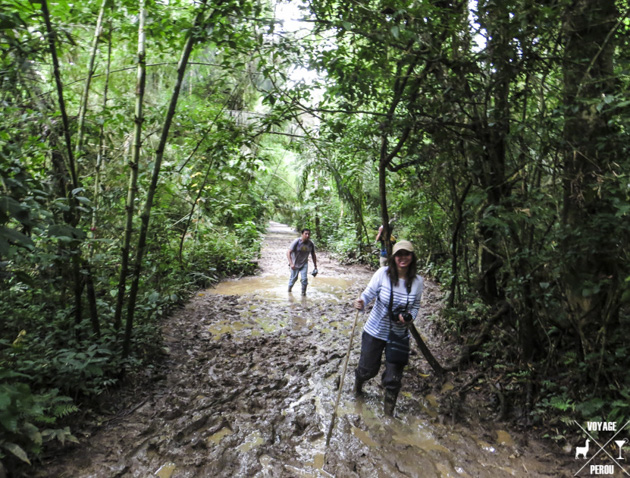
39. Caral
Capital of one of the oldest known civilizations in the Americas, Caral has been declared a UNESCO World Heritage Site and is recognized as the oldest city in the Americas.
Built over 5,000 years ago, Caral stands on the same historical timeline as the great civilizations of Mesopotamia, Egypt, India, and China—yet it remains one of the most underrated archaeological sites in the world.
Spread across more than 15 square miles, the site features six pyramids, circular plazas, ceremonial altars, amphitheaters, and residential complexes made of adobe—an exceptional testament to early urban planning in the Americas.
In my opinion, the best way to visit Caral from Lima is with a guided day tour.
This tour includes hotel pickup in Lima, snacks, a guided visit of Caral, and lunch in Huacho—a hassle-free and informative experience:
Prefer to go on your own? Here’s how to reach Caral by public transport:
- Take a bus to Supe Pueblo (get off at the Supe Market)
- One block away, you’ll find colectivos and taxis heading to Centro Poblado de Caral
- The colectivo drops you about 20 minutes on foot from the entrance
- The taxi takes you directly to the site’s reception
- Important: the last return bus leaves at 4 PM. If using a taxi, agree on a pick-up time with your driver
If you have two days, you could also spend the night in Barranca, enjoy the beach, and visit Caral early the next morning. There are a few simple yet decent hotels in town for an overnight stay.

40. Ayacucho
Ayacucho is a colonial city recognized for its cultural, religious and architectural richness.
However, few international travelers visit it because very little is said about it outside the country.
It has 33 churches, each representing a Year of Jesus, and hosts the largest celebration of Holy Week in Peru.
If you want to go around this time, remember to book your accommodation well in advance because everyone wants to take part in the celebration, believers and non-believers alike!
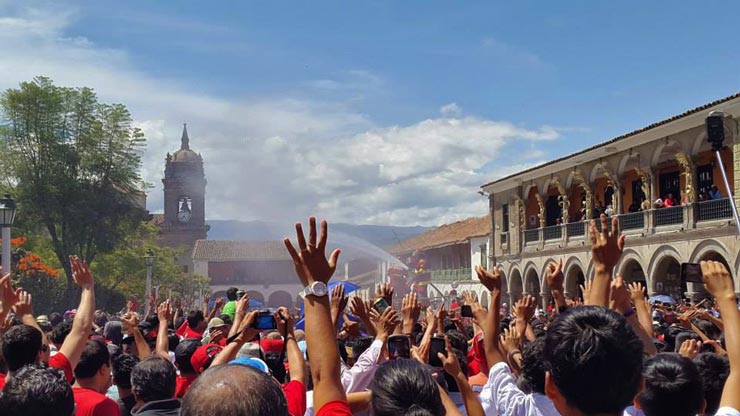
The Top 40 things to see in Peru
Of course, with so many incredible places to explore, it wasn’t easy to narrow it down to this Top 40 list of the best places to visit in Peru.
And you—what would you add to the list?
Book Your Flight at the Best Price
Planning a trip to Peru? To get the best deal on your flights, I recommend using this flight comparison tool, in partnership with Skyscanner.
It’s the easiest way to find the lowest prices for both international flights and domestic flights within Peru—ensuring you pay the best rate with no hassle!
Rent a Car in Peru
Renting a car is one of the best ways to explore Peru at your own pace and make the most of your trip!
Personally, I always use Booking.com Cars for a few key reasons:
- Easily compare prices from all major rental agencies in one place—finding the best deal has never been easier!
- Free cancellation on most bookings, so you can reserve with peace of mind.
- Better insurance coverage at a lower price than rental companies—saving you money with no extra effort.
Click the button below to find the best car rental deals in Peru:
Rent a car
Book entrance tickets and guided visits
Take a travel insurance
Book a tour
✈️ Book your flight
Traveling to Peru? These articles will help you!
Discover all my articles about Peru: All my tips and itineraries to plan your trip in one place!
You’re using Pinterest? Here is the picture to pin!
